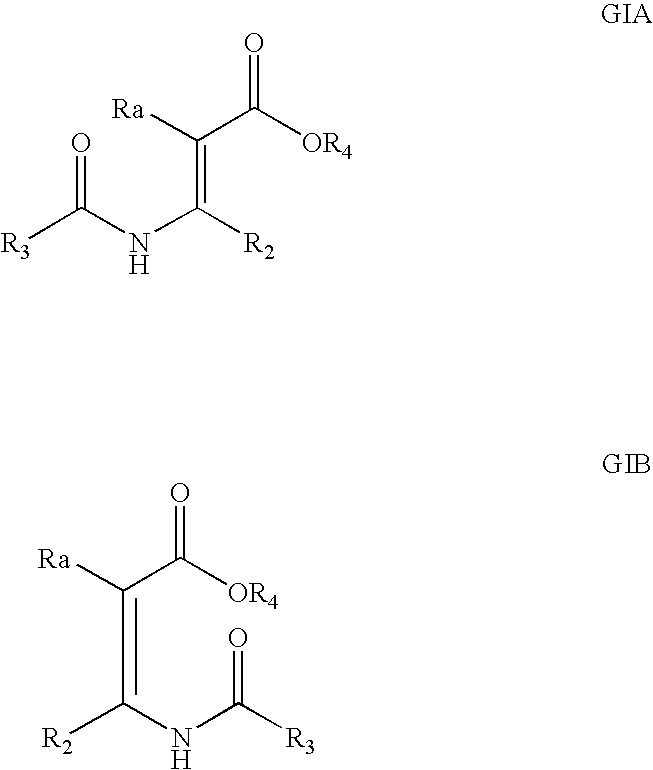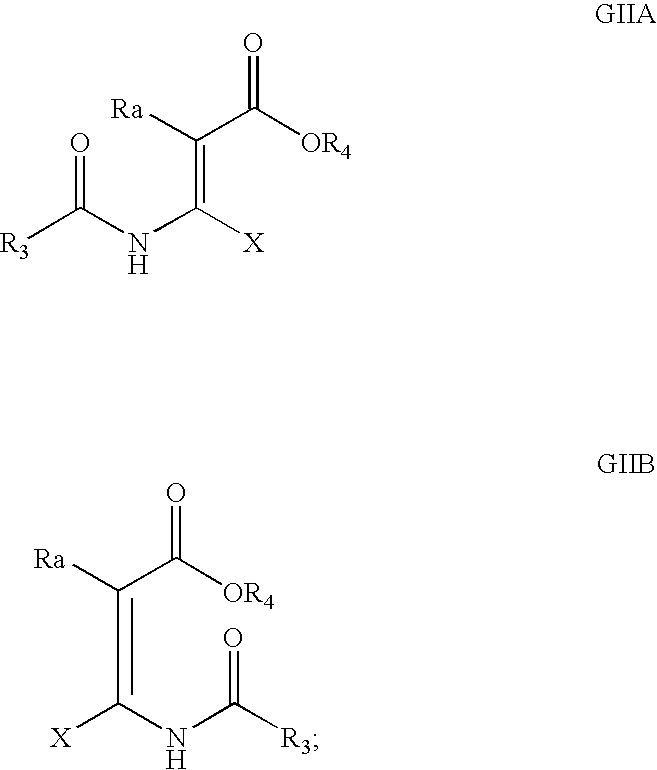Processes and intermediates
a technology of intermediates and caspase inhibitors, applied in the field of intermediates for preparing caspase inhibitors and intermediate derivatives thereof, can solve the problems of disadvantageous synthetic steps, chromatographic separation of diastereomers, and expensive starting materials for producing caspase inhibitors
- Summary
- Abstract
- Description
- Claims
- Application Information
AI Technical Summary
Benefits of technology
Problems solved by technology
Method used
Image
Examples
examples
[0306]The abbreviations used herein are known to skilled practitioners. Scheme 1 the syntheses that are exemplified below.
[0307]
Preparation of 4-bromo-5-ethoxy-5H-furan-2-one
[0308]This procedure may be carried out in a manner similar to that described by C. Escobar, et al., Ann. Quim. (1971), 67, 43-57.). To a solution of 5-ethoxy-5H-furan-2-one (II, R1=Et) (10.0 g, 78.0 mmol) in carbon tetrachloride (50 mL) at 0° C. is added over 0.5 h a solution of bromine (4.05 mL, 78.2 mmol) in carbon tetrachloride (25 mL). The reaction is stirred 1 h at 0° C., then 2 h at room temperature. The solvents are removed under reduced pressure and the residue was short-path distilled at pump vacuum (about 0.5 mm). The fraction collected at 100° C.-120° C. provided 4-bromo-5-ethoxy-5H-furan-2-one (13.2 g, 82% yield) as a yellow oil. 1H-NMR (500 MHz, CDCl3) δ 6.24 (s, 1H), 5.63 (s, 1H), 3.71 (m, 1H), 3.63 (m, 1H), 1.14 (t, J=7.1 Hz, 3H) ppm.
Pd-catalyzed Coupling of CBZ-Pro-NH2 and Bromoethoxyfuranone
[03...
example 2
[0314]
[0315]To a flask was charged the crude product produced as described above (37.36 g, 0.1 mol) and toluene (187 mL). The mixture was stirred to give a beige / brown solution. Seeds of compound 2 (226 mg) were added and the mixture was stirred at ambient temperature for 3 days, at 0-5° C. for 8 hr, then at ambient temperature for another 7 days. The solution was cooled again to 0-5° C. and stirred for 3 hr, filtered, and the solid was rinsed with toluene. The solid was dried in the air to give 5.61 g (15% yield) of the title compound as a 97:3 mixture of anomers.
[0316]1H-NMR (d6-DMSO): δ 7.35-7.25 (m, 5H); 5.75 (d, 1H); 5.70 (d, 1H); 5.1-4.9 (m, 2H); 4.35 (m, 1H); 3.70 (m, 1H); 3.60 (m, 1H); 3.40 (m, 2H); 2.15 (m, 1H) 1.80 (m, 2H); 1.20 (t, 1.5H); 1.10 (t, 1.5H)
example 3
[0317]
[0318]To a flask was charged the compound described in Example 2 (5.00 g, 13.3 mmol), 20% Pd(OH)2 / C (1.00 g, 50% wet), isopropyl acetate (30 mL), and DMF (10 mL). The mixture was hydrogenated under 50 psig H2 at 0-5° C. for 5 hr, then at ambient temperature for 21 hr. HPLC analysis showed the reaction to be 97% complete. The mixture was filtered through celite and the solids were rinsed with a 3:1 isopropyl acetate:DMF solution to provide the unprotected compound of example 2.
[0319]To Cbz-t-leu-OH dicyclohexylamine salt was added isopropyl acetate (30 mL) and 1.0 M H2SO4 (30 mL). The mixture was agitated until two clear phases were obtained. The aqueous phase was discarded and the organic phase was washed with water (30 mL). The organic phase was collected. To the organic phase was added DMF (10 mL), then hydroxybenzotriazole (2.2 g, mmol). EDC (2.8 g) was added and the mixture was stirred for 1 hr. To this mixture was added the above hydrogenation solution. The mixture was st...
PUM
| Property | Measurement | Unit |
|---|---|---|
| temperature | aaaaa | aaaaa |
| temperature | aaaaa | aaaaa |
| temperature | aaaaa | aaaaa |
Abstract
Description
Claims
Application Information
 Login to View More
Login to View More - R&D
- Intellectual Property
- Life Sciences
- Materials
- Tech Scout
- Unparalleled Data Quality
- Higher Quality Content
- 60% Fewer Hallucinations
Browse by: Latest US Patents, China's latest patents, Technical Efficacy Thesaurus, Application Domain, Technology Topic, Popular Technical Reports.
© 2025 PatSnap. All rights reserved.Legal|Privacy policy|Modern Slavery Act Transparency Statement|Sitemap|About US| Contact US: help@patsnap.com



